基于单片机的防火防盗报警系统设计(附程序清单)
无需注册登录,支付后按照提示操作即可获取该资料.
基于单片机的防火防盗报警系统设计(附程序清单)(任务书,开题报告,外文翻译,论文14000字,程序清单,元件清单,PDF电路原理图)
摘要
随着人们生活水平的提高,家庭电器和厨房设施在生活中被广泛地使用,家庭安全隐患也随之增多。城市化程度不断加深,人口聚集现象越发普遍,社会治安问题频发。处在社会转型期的家庭不安全因素也日益凸现,传统的机械式安全防范措施已经跟不上现代化社会的需求。该系统以STC89C52单片机为核心,其硬件电路主要包括单片机、人体检测模块、烟雾检测模块、声光报警模块、GSM短信息报警模块,软件的主要模块有主程序、LCD1602显示子程序、中断处理子程序、声光报警子程序、短信息报警子程序,该系统实现的功能人体检测报警、烟雾检测报警以及手机远程控制,应用和推广的场合为小户型家庭住宅。
关键词:消防;安防;STC89C52;GSM短信息报警
Abstract
With the improvement of people's living standards, household appliances and kitchen facilities are widely used in daily life, and the potential for family safety problems has also increased. The degree of urbanization has continued to deepen, and the phenomenon of population aggregation has become more common. Social security problems have become more frequent. Insecurity in the family during the social transition period has also become increasingly prominent. The traditional mechanical safety precautions have not kept pace with the demands of the modern society. The system is based on STC89C52 microcontroller. Its hardware circuits mainly include single-chip microcomputer, human detection module, smoke detection module, sound and light alarm module, and GSM short message alarm module. The main modules of the software include main program, LCD1602 display subroutine and interrupt handler. Programs, sound and light alarm subroutines, short message alarm subroutines, functions of the system to achieve human detection alarm, smoke detection alarm and mobile phone remote control, application and promotion of the occasion for small family homes.
Key words:Fire Protection; Security; STC89C52; GSM Short Message Alarm
设计内容
本设计硬件部分是由单片机、烟雾传感器、红外传感器、 LCD显示模块、 GSM报警模块组成的电路, 烟雾传感器采集环境中的烟雾浓度值,经过单片机数据处理后,在 LCD屏上显示环境中的烟雾浓度,并且在该设计中在确定烟雾浓度的报警阈值后,一旦环境中的烟雾浓度值超过程序所设定的报警值, 或者有陌生人进入监测环境中时,蜂鸣器报警和 LED点亮。 与此同时GSM会向预设号码发送短信息通知报警。 使用者不仅可以在实物上进行布防、撤防和紧急报警,还可以在手机端向设备发送号码进行远程控制
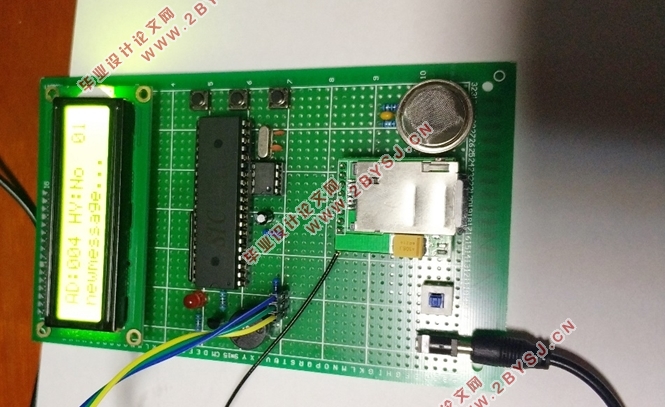
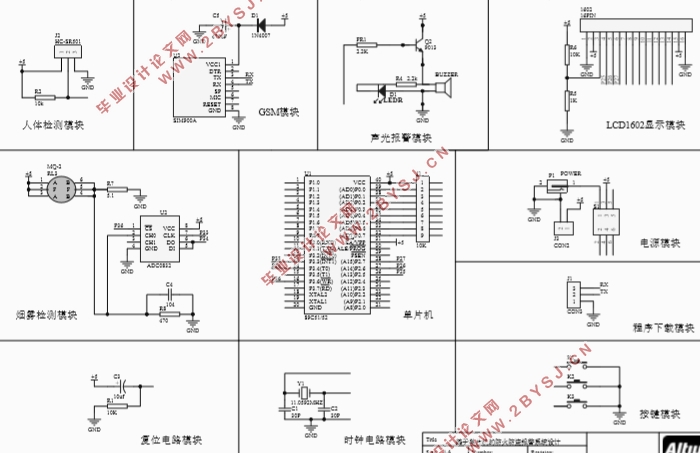
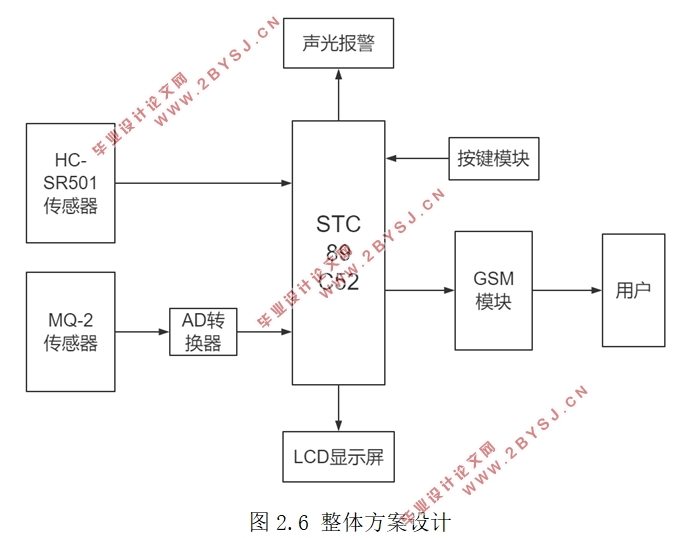
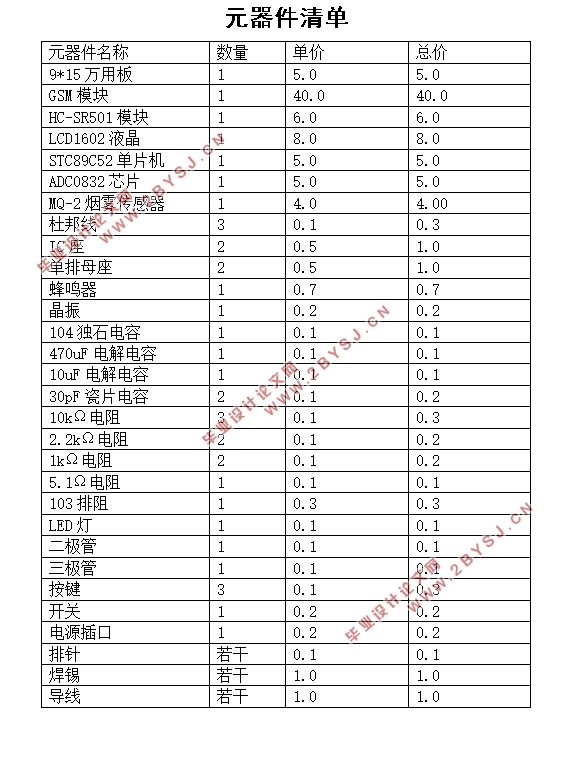
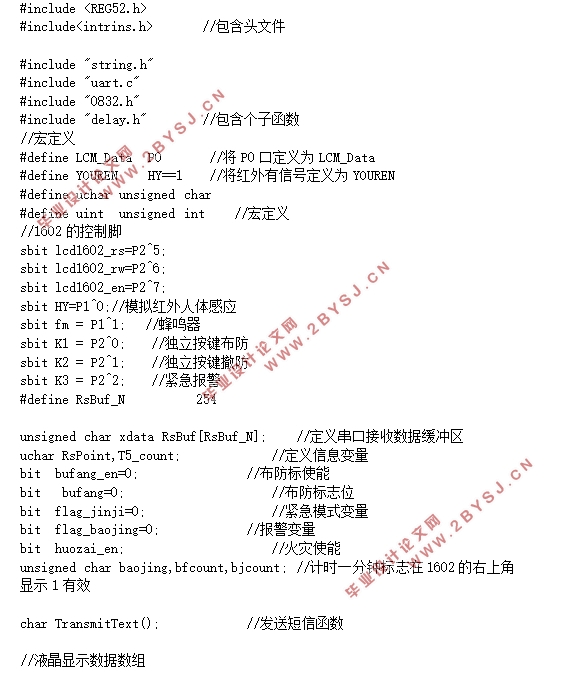
目录
第1章绪论 1
1.1 设计的背景、目的和意义 1
1.2 国内外现状 1
1.3 设计内容 3
第2章设计方案的比较与选择 4
2.1 应用环境分析 4
2.2 总体设计选择方案 5
2.3 单片机选择 6
2.4 传感器的选择 7
2.2.1 火灾检测传感器的选择 7
2.2.1 人体检测传感器的选择 8
2.5 无线通信模块的选择 9
2.5.1 无线通信技术的选择 9
2.5.2 GSM无线通信介绍 10
2.5.3 SIM900A介绍 10
2.6 开发语言和平台的选择 10
2.6.1 开发语言的选择 10
2.6.2 开发平台的选择 11
2.7 本章小结 11
第3章硬件电路设计 13
3.1 系统概述 13
3.2 系统电路分析 13
3.2 单片机最小系统电路 13
3.2.1 时钟电路 13
3.2.2 复位电路 13
3.4 程序下载电路 14
3.5 声光报警电路 15
3.6 传感器电路 16
3.6.1 人体检测传感器电路 16
3.6.2 火灾检测传感器电路 17
3.7 LCD1602显示电路 20
3.8 GSM模块电路 22
3.9 本章小结 23
第4章软件设计 24
4.1 程序功能分析 24
4.2 系统程序设计 24
4.2.1 系统主程序流程图 24
4.2.2 中断处理子程序流程图 25
4.2.2 GSM短信息发送子程序 26
4.2.4 GSM短信息接收子程序 28
4.3 本章小结 29
第5章实物调试与设计评价 30
5.1 实物调试 30
5.2 设计评价 32
第6章总结与展望 34
6.1 总结 34
6.2 展望 34
6.2.1 复杂环境的布点 34
6.2.2 传感器的增改 35
6.2.3 通信技术的增改 35
参考文献 37
致谢 38
